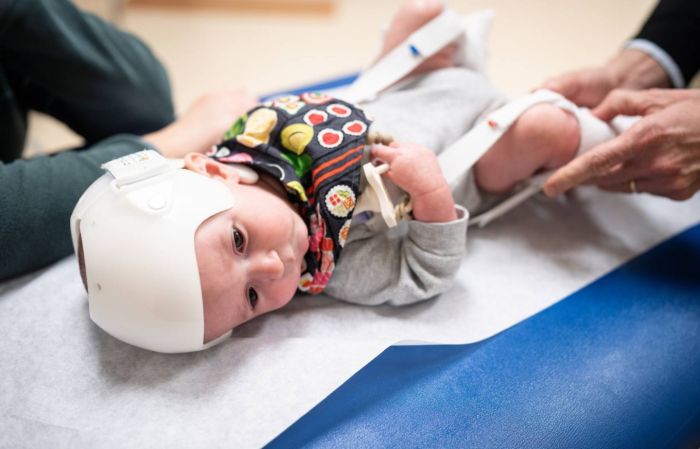What is developmental dysplasia of the hip?
Developmental dysplasia of the hip (DDH) is a condition that occurs when the hip joint abnormally forms or grows in babies and young children. If the ball of the hip joint is not in the correct position within the socket, then the hip joint cannot develop as it should. There is a range of severities of DDH, with the most severe being a dislocated hip. If left untreated, a baby born with a dislocated hip(s) can eventually experience abnormal walking. Even individuals with less severe DDH can develop hip pain and early arthritis.
There are a number of reasons a baby might be diagnosed with developmental hip dysplasia. First-born infants and females are at higher risk, as are babies who were in the breech position during pregnancy or those who have a family history of DDH. After birth, swaddling of the hips can also cause DDH.
While hip dysplasia in infants can be hard to detect, healthcare providers should always screen for it during routine checkups. If an infant/child has risk factors or concern for DDH during their exam, imaging of the hips with either an ultrasound or x-ray should be performed. This helps healthcare providers get a better look at how the hip joint is aligned and developing.
How is DDH treated?
After a DDH diagnosis, it is important to begin treatment right away. The earlier it is diagnosed, the higher the chances are of correcting the concern. The good news is that there are a number of treatment options to choose from before DDH hip surgery.
A Pavlik harness is the first line of treatment used to treat DDH for babies 6 months of age or younger. The harness holds the ball of the hip joint in the socket, allowing the soft tissues around the hip joint to tighten and the hip socket to deepen. Babies usually wear the harness full-time for 6-12 weeks. In some cases, the pediatric orthopedic provider might gradually reduce the time the baby spends in the harness.
A hip abduction orthosis is a brace that holds the child’s hips in the proper position for hip development. This type of brace can be used from infancy to about 3 years of age and is worn full-time or part-time depending on the severity of DDH. This form of bracing is rarely used as the first type of bracing in young infants.
Is surgery needed to correct developmental hip dysplasia?
If bracing is unsuccessful in treating hip dysplasia in infants, a surgery called “closed reduction procedure” may be needed. While the child is under general anesthesia, an orthopedic surgeon moves the child’s hip back into place by hand with no surgical incisions. Children are then placed into a spica, or body cast, to hold the hip in the appropriate position.
Another option is an open reduction surgery. During open reduction surgery, a pediatric orthopedic surgeon places the dislocated joint back into its proper place by making an incision in the front of the hip. The child is then placed into a spica cast after the procedure. A brace may also be needed after casting to help keep the hip from dislocating again.
Osteotomy is another procedure in which the surgeon cuts and/or realigns a child’s femur/thighbone or pelvic bone to place the ball of the hip joint in a better position within the socket. After surgery, a cast will help keep the hip(s) in place. During this time, it will be necessary to use a wheelchair or carry your child. It is important to temporarily stop all activities including walking until the surgery has healed properly. If not, it can lead to more damage and pain.
While physical therapy may be useful for some patients, most children with DDH do not require it unless they are older or have had osteotomy surgery. Your provider will always communicate your options and explain the best road to recovery.
Developmental Hip Dysplasia Care at Gillette Children's
Each child is unique. Seeing the medical experts at Gillette Children’s means you get world-class care from a multidisciplinary team of professionals, all in one place. If you are concerned that your child may have developmental dysplasia of the hip, we can evaluate and create a treatment plan tailored to their specific needs, whether or not they require surgery.
Do you suspect your child may have DDH or another orthopedic, neurological, or movement condition? Request a Pediatric Expert Consult with one of Gillette's board-certified clinicians.
 Home Page
Home Page

